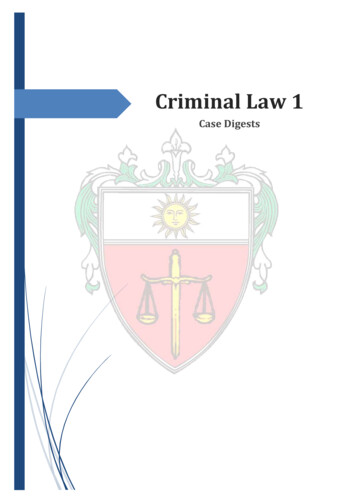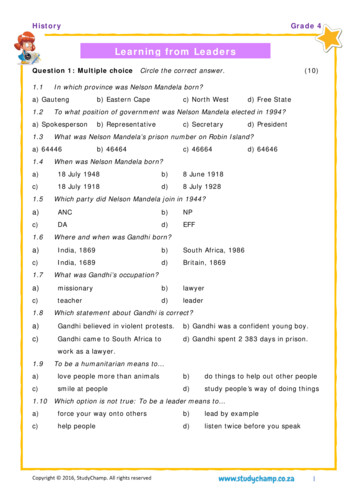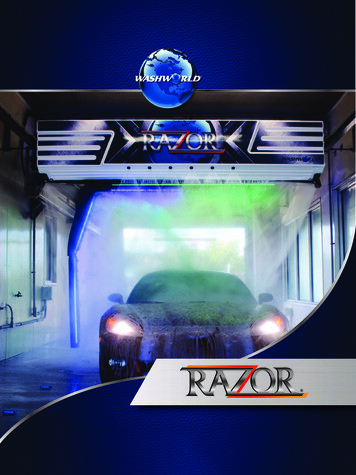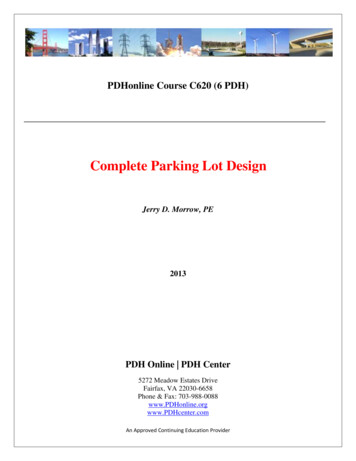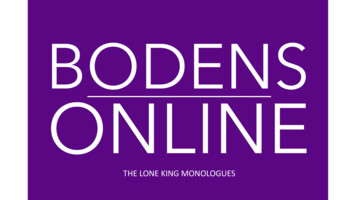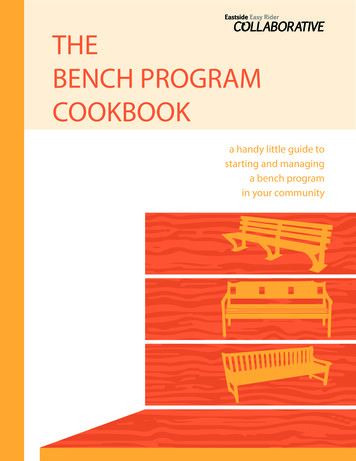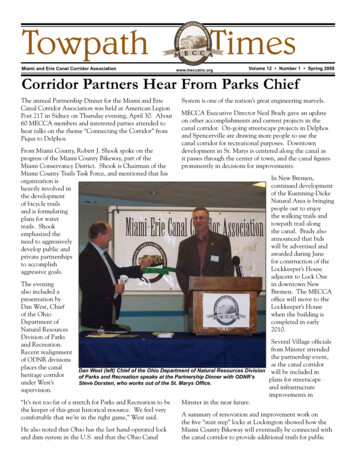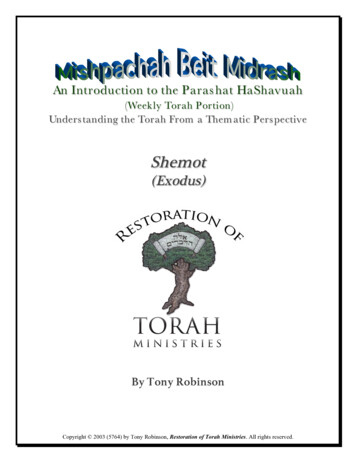
Transcription
An Introduction to the Paras hat HaShavuah(Week ly Torah Portion)Unders tanding the Torah From a Them atic Pers pectiveShemot(Exodus)By Tony RobinsonCopyright 2003 (5764) by Tony Robinson, Restoration of Torah Ministries. All rights reserved.
—The Family House of Study—Examining the Parashat HaShavuah byThematic AnalysisWelcome to Mishpachah Beit Midrash, the Family House of Study. Each Shabbat1 we gather inour home and study the Scriptures, specifically the Torah.2 It’s a fun time of receiving revelationfrom the Ruach HaKodesh3. Everyone joins in—adults and children—as we follow the ParashatHaShavuah4 schedule. We devote ourselves to studying the Torah because the Torah is thefoundation for all of Scripture. Therefore, a thorough understanding of the Torah will help usmore fully understand the rest of the Tanakh5 and the Brit Chadasha.6 Furthermore, as Yeshuastated Himself, the Torah teaches about Him. So we study the Torah in order to be drawn closerto Yeshua, the goal of the Torah.As believers in the Messiah we have discovered the richness of the wisdom of the sages of Israel.These men, who devoted themselves to the study of the Torah, have left us a rich heritage. Partof that heritage is a unique method of learning and interpreting the Scriptures. It’s calledthematic analysis. In thematic analysis we search for the underlying theme/topic of each passageof Scripture. By studying Scriptures related by a common theme, line upon line and preceptupon precept, the Scriptures open up to us in a unique manner that is clearly inspired by theRuach HaKodesh. Passages that seemed obscure begin to make sense, and numerous levels ofwisdom and understanding unfold before us.Thematic analysis of Scripture is based on the following premises. 1) Moses wrote the Torah asfive separate books as the Ruach HaKodesh inspired him. 2) Since Adonai had him separatethose words into five separate books, we surmise that each book has a unique message or theme.3) Within each book, the words are written with two paragraph-like divisions7 interrupting theflow of the words. 4) Since Adonai commanded Moshe to separate the individual books intosmaller paragraph-like sections or Parshiot, we surmise that each Parsha was written as aseparate unit because each of those Parshiot is trying to convey a unique thought, theme, conceptor understanding. Therefore, since Adonai inspired these divisions, we think they are VERYimportant. We use these God-breathed divisions as the basis of our thematic analysis ofScripture. Once you begin to interpret the Scriptures thematically, you will immediately SEEthat Adonai wrote His words in a manner consistent with the intent that they be interpretedthematically.Here is an example of what the Parsha divisions look like Page 2 of 12
s—Parsha Stumah (plural, stumot)—A paragraph-like break inspired by the Ruach HaKodesh,still preserved on kosher Torah Scrolls, where there are at least nine blank spaces between aword and the next word, all on the same line of text.p—Parsha P'tuchah (plural, p'tuchot)—A paragraph-like break inspired by the Ruach HaKodesh,still preserved on kosher Torah Scrolls, where there are blank spaces extending to the end of aline of text and the subsequent text does not begin until the next line. (Hebrew is read from rightto left)Page 3 of 12
Parashat HaShavuahtAm.vShemotShemot 1:1 - 6:1(Exodus 1:1 - 6:1) Shemot 1:1 - 1:7 pShemot 1:8 - 1:22 pShemot 2:1 - 2:22 pShemot 2:23 - 2:25 sShemot 3:1 - 4:17 pShemot 4:18 - 6:1 pUnderstanding the ParshaShemot 2:1 - 2:22In this section we will analyze one parsha to discover its primary theme and how that theme relates to the rest of theTorah.Page 4 of 12
Objective—Learn how to interpret the main theme of a Parsha. Find other Scripturesthematically connected with the Parsha under examination. Understand how the thematicconnections help you to interpret the significance of the Parsha under examination.I. In order to determine the overall theme of a passage, it's good to outline it and study thetopics of the outline first. Read the passage and establish a general outline of the flow ofevents.A. 2:1-10—Moses escaped deathB. 2:11-15—Moses in conflictC. 2:16-22—Moses' life in exileII. Moses Escaped DeathA. Can you think of any Scriptures thematically related to verses 1-4?8B. Based on the thematic connection above, what do you think is the main theme ofverses 1-4?9C. In this instance, note how we used a thematic connection to another Parsha tohelp us interpret the events.III. Moses in ConflictA. How is the story of verses 11-12 thematically related to verses13-14?10B. Based on the thematic connection above, what do you think is the main theme ofverses 11-15?11C. In this instance, note how we used a thematic connection within the Parsha to helpus interpret the events.IV. Moses' Life in ExileA. How is the story of verses 16-22 thematically related to the theme of verses 1115?12B. What is the significance of this connection?13C. What other Scriptures from Genesis are thematically related to verses 15b and 21?Note the well!14V. Moses the LeaderA. Read the following verses (Exodus 2:11-22; 3:10; and 4:18) and think of athematic connection between another character in the Torah! Here's some help.1. In Exodus 2:13-14 Moses is in conflict with one of his "brothers".2. In Exodus 2:13-14 Moses is rejected by one of his "brothers," whostates, "who made you judge and ruler over us."3. Exodus 2:15 and 22 show that Moses flees and lives in exile (Midian)from His brothers.4. Exodus 2:16 and 21 show that Moses married the daughter of a priest.5. Exodus 2:11 and 4:18 show that Moses went to see how his brotherswere doing.6. In Exodus 4:29-31 Moses is re-united with his brethren who now accepthis leadership.B. In case you didn't get the thematic connections, here they are.1. Was not Joseph in conflict with his brothers?Page 5 of 12
2. Wasn't Joseph rejected (first time he was with them) by his brothers?3. Wasn't Joseph sent in exile, away from his brothers when he was takento Egypt?4. Didn't Joseph marry the daughter of the priest of On?5. Wasn't Joseph sent to see how his brothers were doing in Shechem?6. Wasn't Joseph accepted by his brothers when they were reunited anddidn't they also accept his leadership the second time?C. Now, I ask you, why are these thematic connections so numerous and sospecific?15VI. The Theme of This ParshaA. First, through thematic analysis, note the numerous thematic connections to thecharacter of Moses and his call to lead Israel.B. Then, note his two foiled attempts to act in that leadership role.C. The end result was exile for 40 years.D. Using my original outline I would summarize the Parsha as follows.1. Moses Escaped Death—This section focuses on the preservation of Moses[remember circumstances related to his birth] in order to lead Israel.2. Moses in Conflict—This section focuses on his sense of inner calling to leadIsrael [remember incidents of conflict in Egypt]3. Moses Life in Exile—This section focuses on the exile of the would-be leader.Thus, although Moses is clearly designated to lead Israel out of bondage, it seems that forsome reason, his timing may not have been correct. A short phrase that may capturethese three concepts, may be Moses' False Start at Leadership? Can you think ofanother? My analysis isn't necessarily the best.Searching the ParshiotObjective—Learn how to 1) uncover the theme of a passage, 2) relate them to other passagesand 3) gain new insight on how to interpret the original passage based on its thematicconnection to those other passages.I. Read Exodus 3:1-6.A. How is the fact that Adonai spoke from a "burning bush" thematically connectedto his revelation to Abraham?16B. How is Adonai's revelation to Moses different than how He revealed Himself toour Fathers?171. When we contrast how Adonai is beginning to reveal Himself to Israelnow, with how He revealed Himself in the past, we will begin to see somebig differences. We will follow this emerging theme of approachability toAdonai closely, as it will become a primary topic throughout the rest of theTorah. This is it's one of the first clear instances of this theme.Page 6 of 12
II. Miscellaneous Thematic Connections Throughout the Scriptures—Here are somethematic connections for your perusal. These suggested by my wife and children. I amlisting them so that you can get a flavor for how to see them. After going through thislist, see if you can come up with any on your own.A. Moses led the children of Israel out of slavery Yeshua leads us out of slavery tosin.B. Moses trained forty years in the desert The children of Israel were tested fortyyears in the wilderness Yeshua, the Good Shepherd, was tested forty days in thewilderness.C. Joseph took Yeshua down to Egypt until those seeking His life had passed away Moses was in Midian until those seeking his life had passed away.D. In Exodus 4:8, Adonai gave Moses signs/miracles to perform so that if thechildren of Israel don't believe his message, they'll believe because of thesigns/miracles Yeshua told people that they should believe Him because of themiracles He did.E. Moses demonstrated that he had power over leprosy Yeshua also had powerover leprosy, which was known to be a sign of the Messiah.III. We saw two examples of a flight to Egypt by someone destined to lead others. After thedeath of those who sought their lives, the future leader returned to begin their leadershiprole. This theme is not unique to types of the Messiah.A. Read I Kings 11:14-22. After reading this story, determine how this story isthematically connected to the story of Joseph (son of Jacob), Yeshua and Moses’flight to Egypt. After coming up with some connections examine the following:1. In all three stories, all of the male children were killed!2. In all three stories, someone who was destined to be ruler of their peoplehad to flee to Egypt in order to spare their lives!3. In the story of Hadad the Edomite and Moses, they were both raised inPharaoh’s court!4. Although Joseph was sold into slavery (as opposed to fleeing there),Joseph is still thematically connected to the story of Hadad as follows.Both of them were given a wife who was part of the ruling class ofEgypt.185. Both Hadad and Joseph found favor in Pharaoh’s eyes!6. Hadad’s son, Genubath, was weaned in Pharaoh’s house, just as Moses,the adopted son of Pharaoh’s daughter, was reared in Pharaoh’s house!7. Moses, Hadad and Yeshua all returned to their homeland after the deathsof those who had persecuted them!B. Now read I Kings 11:39-40. Does this story look familiar? Of course it does. Sowhat’s going on here? I’ve mentioned these connections because I want toimpress upon you the importance of understanding how to read the Scripturesthematically. After reading the examples above, it should be extremely obviousthat the Holy One recorded these stories, with their connections, on purpose.They help teach us the general principal that sometimes, those destined forleadership are molded in the crucible of persecution. Each of these future leadersspent time fleeing for their lives. Someone wanted to kill them to prevent theirrule; however, by fleeing to Egypt, their lives were spared. These examples alsoPage 7 of 12
show us the role that Egypt plays. Egypt is a picture of the world. At this point, Idon’t fully understand the full meaning of the connections above; however, Iknow that they are intentional and important. Might you have moreunderstanding concerning the meaning of these connections? If not, don’t worry,in time, Adonai will show us all things.Making the Connection Between the Parashat HaShavuahand the HaftarahObjective—Learn how to relate Scriptures thematically, thereby learning how to thinkHebraically. Become rooted in the importance of thematic analysis by seeing it in action as yourelate the Torah portion to the Haftarah portion.The Haftarah reading is found in Jeremiah 1:1 - 2:3. I will list some verses from the Haftarahreading. Your job will be to relate them thematically to the Parashat HaShavuah reading.I. What theme in verses 1:4-5 is thematically connected with a theme of the Torahreading?19II. What theme in verse 1:6 is thematically connected with a theme of the Torah reading?20III. What theme in verse 2:1-3 is thematically connected with a theme of the Torah reading?21If you would like to explore more information about connections between the Torah portion andthe Haftarah reading, then go to the Haftarah Connections link on our website under The WeeklyTorah Portion. You will be able to download a document that will show you numerousScriptures from the Haftarah reading so that you can determine how they are thematicallyconnected to the Torah portion. The answers are provided as endnotes. This is an excellentexercise to help you begin thinking thematically.Messiah in the ParshaObjective—Learn how the Torah teaches about the life and ministry of Yeshua HaMashiach.Yeshua said that Moses wrote about Him22. Even though the Torah never mentions the wordMessiah, this section will help you see the Messiah in the Torah. This can primarily be doneusing thematic analysis and Midrash. As Yeshua walked with the two disciples along the road toEmmaus, could He have used some of the following analysis to show them how Moses [first fivebooks only] taught about Him?I. In Understanding the Parsha, we thematically analyzed the Scripture from the level ofpashat (literal interpretation). Now let's use the Midrash to see if we can find teachingPage 8 of 12
II.III.IV.V.concerning the person and work of the Messiah, Yeshua. In section II of Understandingthe Parsha we saw how Moses escaped death. Now let's see one of the most beautifulways the Torah points us to the Messiah. As we learned in the book of B'reishit(Genesis), anytime we see 1) pictures of resurrection, 2) pictures of renewed life as aresult of deliverance from impending death and 3) pictures of victory and life as a resultof death, we know the Torah is about to give us a teaching concerning the Messiah. I callthese themes of The Resurrection and the Life, and they are especially strengthenedwhen coupled in some manner with the number three.The Resurrection and the Life in the TorahA. The first LIVING things (plants, grass, etc.) were created on day THREE!B. The Torah's picture of the RESURRECTION of the Messiah is found in theHoly Days. The Holy Day that is a shadow of Yeshua's RESURRECTION isthe THIRD Holy Day, the Day of the Omer Wave Offering!C. Jonah, who was in the belly of a great fish, should have been dead. But on theTHIRD day he came forth ALIVE!D. The akeida (binding of Isaac) found in Genesis 22—Abraham was supposed tooffer Isaac as a whole burnt offering. Although Adonai prevented him fromactually sacrificing Isaac on the THIRD day, the manner in which the Torahrelates the story hints that Isaac died and was RESURRECTED. That's whyHebrews 11:17-19 says that Abraham received Isaac from the dead throughRESURRECTION figuratively!Read Exodus 2:1-10 again.A. What was Pharaoh's decree concerning the birth of male babies?23B. What was supposed to happen to Moses?24C. How long did Moses' mother hide him?25D. By taking Moses out of the Nile River, what did the daughter of Pharaoh do?26E. So we see the Torah has painted a picture of a child, Moses, who was supposed todie. His mother hid him for THREE months, then she obeyed Pharaoh'scommand by casting him into the water (in the basket). But Pharaoh's deathsentence was cancelled when his daughter took Moses out of the river, and he wasgiven LIFE!F. What does this story tell us?271. Through this story the Torah is trying to teach us that Moses' life will bea picture of the Messiah! We will continue to comment on how Moses'life is a picture of the Messiah as we study future lessons.2. We also learned in Genesis that the events in the lives of our Fathers willbe repeated in the lives of their descendants. How is this event in thelife of Moses a prophecy of a future event relating to the Messiah?28We saw in Genesis that Joseph's entire life is a prophecy of the work of the Messiah. Wesaw in section five of Understanding the Parsha that Moses' life is thematically connectedwith Joseph's. What is the Messianic significance of that thematic connection?29Moses, a Shadow of Messiah—As we read the beginning of Exodus we note that eventhough Moses is a Hebrew, his upbringing is totally different than that of his brethren. Isthe Torah teaching us anything about the Messiah through this contrast?A. As a New Covenant believer, what do we know about the Torah's picture of thechildren of Israel in slavery to Egypt?30Page 9 of 12
B. In order for Moses to lead the children of Israel out of Egyptian bondage, whatstatus change did he need to make?31C. What is the Torah trying to teach us about the Messiah through Moses as youconsider points A & B above?1. The fact that Moses did not participate in the Egyptian slavery is apicture of how Yeshua did not partake in our sin nature. The Hebrewslavery was a picture of man's slavery to sin. Yeshua did not participatein slavery to sin any more than Moses partook of the Hebrew slavery.2. The fact that Moses had to step down from his princely position andidentify with his brethren, the Hebrews, is a picture of how Yeshuaemptied Himself of His divinity so that He could identify with us and beobedient unto death. In other words, Moses is a picture of thePhilippians 2:5-8 experience of Yeshua!Through Torah pictures and midrash we can see clearly how the Torah teaches us,in ways we can understand, the deep mysteries concerning Yeshua our Messiah.Truly, Moses was the greatest prophet of the Messiah, even though he never onceeven mentioned the word Messiah!Fun For the Whole FamilyOkay, time to show what you’ve learned. Word searches and crossword puzzles areavailable for you to test your understanding. The word search for adults (and olderchildren) consists of 20-30 words taken from this week’s sidra (portion). Some of thewords may be common Hebrew words or English phrases. The crossword puzzle foradults (and older children) may also contain common Hebrew words or English phrases.There is also a word search for the little guys! And of course, the answer key isprovided for the crossword puzzle.Adult and children’s crossword puzzles and word searches are available on Restoration ofTorah’s website: www.restorationoftorah.org. Click on the link entitled, The WeeklyTorah Portion Crossword Puzzles and Word Searches.Shabbat Shalom!1Shabbat is Hebrew for Sabbath.2In its most limited form, the Torah comprises the first five books of Moses.3Holy Spirit.Page 10 of 12
4The Parashat HaShavuah, or weekly Parashat, are the weekly readings from the Torah. Each week, beginning onthe Shabbat, we read specific selections from the Torah, such that we complete the entire Torah each year.5Tanakh is the entirety of what is commonly called the Old Testament. It is a Hebrew acronym taken from the threemajor divisions of the Tanakh: the Torah, Prophets (Neviim) and Writings (Khetuvim).6Brit Chadasha is commonly known as the New Testament Scriptures.7This paragraph-like division is called a Parsha (Parshiot, plural).8These verses are thematically connected to the account of the flood. 1) Moses was placed into a basket just asNoach was placed into an ark. 2) In both cases the ones in the "ark" were preserved from death by water. 3) Both"arks" were smeared with pitch.9In the flood account Adonai 1) sends a judgment against the ungodly, 2) saves/preserves the righteous through thesame judgment, 3) establishes a covenant with the one saved/preserved and 4) the ones saved/preserved go on toestablish a new earth in hopes that mankind will walk according to Adonai's commandments. Since Adonai is aboutto 1) send judgment against the ungodly [Egyptians], 2) save/preserve the righteous [Israel] through the samejudgment, 3) establish a covenant with the one saved/preserved [Israel] and 4) the ones saved/preserved [Israel]go(es) on to establish a new land in hopes that mankind will walk according to Adonai's commandments [Torah],could the Torah be hinting that the theme of these verses is that Adonai wants to use Moses in a role similar toNoach's?10In both stories Moses is trying to defend the cause of the weaker/oppressed person (the one who is at adisadvantage).11Since both stories relate how Moses is standing up for the oppressed, I think these verses are trying to teach usabout Moses' character. They teach that 1) Moses hated injustices, 2) he cared for the disadvantaged, 3) he couldidentify with the weak, and 4) he was a man of action willing to remedy the situation.12Once again we see Moses coming to the rescue of a weaker/disadvantaged person (the women at the well vs. themale shepherds).13This is now the third story relating to Moses' character and sense of justice. Therefore, the Torah is making agreat effort to get us to understand Moses' character and what motivates him.14These Scriptures show that Moses met his wife at a well. In Genesis 24 Abraham's servant meets Isaac's wife,Rebecca, at a well. In Genesis 29 Jacob met Rachael, his future wife at a well. Furthermore, in all three instances asignificant event of kindness was demonstrated. Rebecca filled hoisted almost 250 gallons of water for the servant'scamels. Jacob moved the huge rock from over the well mouth by himself. Moses defended the daughters of Jethro.15Because the Torah is trying to teach us (at the pashat [literal] level) that Moses is being called to fulfill a rolesimilar to Joseph's. Moses will be instrumental in securing life for the Israelites just as Joseph preserved their livesduring the seven years of famine! The Torah teaches this through the thematic connections.16In Genesis 15:9-17 Adonai appeared as a smoking furnace. These are two instances where Adonai's appearance isassociated with fire. This will become a significant theme throughout Scripture. So let's keep an eye on it.17In this account there is an element of un-approachability between Adonai and Moses ("do not come closer"). Thiswas not present throughout Genesis.18Joseph’s wife was the daughter of one of the priests of Egypt.19Jeremiah is called to be a prophet just as Moses received his calling to be prophet and spokesman for Adonai.Page 11 of 12
20Jeremiah was reluctant to accept the calling just as Moses made excuses concerning his calling.21An allusion is made back to the time of the Exodus when Israel was Adonai's first born as it states in Exodus 4:2223. Also, judgment was promised to those who would harm Israel just as judgment came to Egypt.22Yeshua said in John 5:46 that Moses spoke about him. Psalm 40:6-8, speaking of the Messiah said that the bookis written about Him. Paul said that all of the feasts were prophetic shadows of Messiah Yeshua.23All male babies were to be thrown to their death into the Nile river.24He was supposed to die.25Three months.26She took one who was supposed to die and gave him LIFE.27This story tells us that the events surrounding Moses' life relate in some manner to the Messiah! This powerfultheme should be like a neon light pointing you to the Messiah.28In Matthew 2:16 we read that King Herod slew all male babies two years of age and below in an attempt todestroy Yeshua the deliverer just as Pharaoh had tried to destroy Moses by slaughtering male infants.29Since the Torah has linked Moses to Joseph thematically and since Joseph is such a powerful Messianic shadow,we should expect Moses to also be an important shadow of the Messiah. We will examine this theme more as westudy.30The Egyptian slavery of the children of Israel is a picture of the slavery of all mankind to sin! Just as the childrenof Israel could not deliver themselves from Egyptian bondage, neither can mankind deliver himself from thebondage of sin (Romans 6-8).31He was born and raised as a prince in Egypt. Acts 7:22-23 states that as an Egyptian, Moses was mighty in wordand deed. However, before he became the leader of Israel, he had to leave his high princely Egyptian position andbecome like his brethren, a Hebrew. When he went before Pharaoh, he did so as a lowly Hebrew, not a prince ofEgypt.Page 12 of 12
still preserved on kosher Torah Scrolls, where there are at least nine blank spaces between a word and the next word, all on the same line of text. p—Parsha P'tuchah (plural, p'tuchot)—A paragraph-like break inspired by the Ruach HaKodesh, still preserved on kosher Torah Scroll

